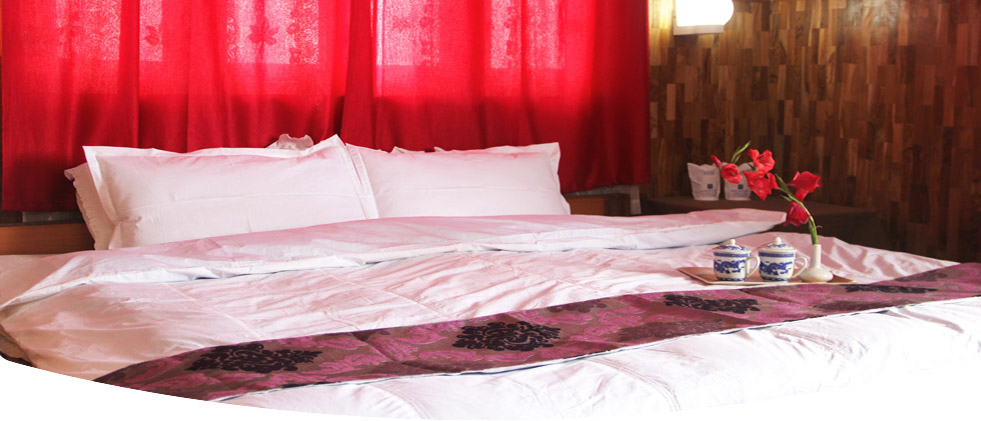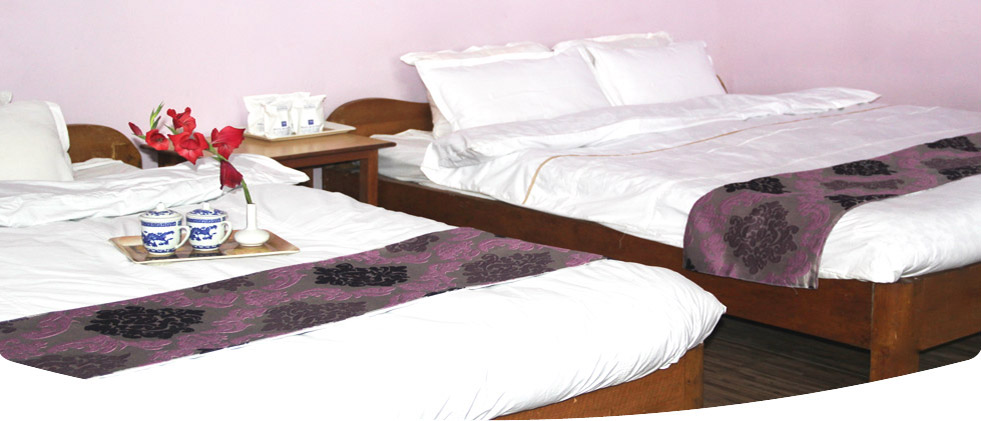Welcome to Blue Hills Pelling
 Tsongmo Lake or Changu Lake is a glacial lake in the East Sikkim, India, some 40 kilometres (25 mi) away from Gangtok at altitude of 3,780 m (12,400 ft).The road to Nathu La passes the lake on north side. The Chinese border crossing is only some 5 kilometres (3.1 mi) east-northeast in a straight line, but some 18 kilometres (11 mi) by road.
Tsongmo Lake or Changu Lake is a glacial lake in the East Sikkim, India, some 40 kilometres (25 mi) away from Gangtok at altitude of 3,780 m (12,400 ft).The road to Nathu La passes the lake on north side. The Chinese border crossing is only some 5 kilometres (3.1 mi) east-northeast in a straight line, but some 18 kilometres (11 mi) by road.
 Rumtek, also called the Dharmachakra Centre, is a Tibetan Buddhist monastery located in the Indian state of Sikkim near the capital Gangtok. It is a focal point for the sectarian tensions that characterize the Karmapa Controversy.Rumtek is located 24 km from Gangtok, the capital of the Sikkim, at an altitude of about 1500 m.
Rumtek, also called the Dharmachakra Centre, is a Tibetan Buddhist monastery located in the Indian state of Sikkim near the capital Gangtok. It is a focal point for the sectarian tensions that characterize the Karmapa Controversy.Rumtek is located 24 km from Gangtok, the capital of the Sikkim, at an altitude of about 1500 m.
 The Enchey Monastery was established in 1909 above Gangtok, the capital city of Sikkim in the Northeastern Indian state. It belongs to the Nyingma order of Vajrayana Buddhism.The monastery built around the then small hamlet of Gangtok became a religious centre. The location was blessed by Lama Drupthob Karpo,a renowned exponent of with flying powers
The Enchey Monastery was established in 1909 above Gangtok, the capital city of Sikkim in the Northeastern Indian state. It belongs to the Nyingma order of Vajrayana Buddhism.The monastery built around the then small hamlet of Gangtok became a religious centre. The location was blessed by Lama Drupthob Karpo,a renowned exponent of with flying powers
 MG Road is the main commercial area of Gangtok. All major shops, banks,restaurants etc are located in around this place. The main part is kept for pedestrians and no vehicle can enter the main part of the road. It is like a plaza and seating arrangements are made at the middle row for the people to sit and enjoy the place.
MG Road is the main commercial area of Gangtok. All major shops, banks,restaurants etc are located in around this place. The main part is kept for pedestrians and no vehicle can enter the main part of the road. It is like a plaza and seating arrangements are made at the middle row for the people to sit and enjoy the place.
• Dodrul Chorten • Namgyal Research Institute of Tibetology (NRIT) • Tashi View Point • Rumtek Dharma Chakra Centre • Nathula Pass • Lungsen • Himalayan Zoological Park • Pal Zurmang Kagyud Monastery.
 Khecheapairi Lake is considered to be one of the sacred lakes of this State both by the Buddhist and the Hindus. The Lake remains hidden in the rich forest cover. It is believed that birds do not permit even a single leaf to float on he Lake surface. There is a rnotorable road from Pemayangtse right up to the lake area.
Khecheapairi Lake is considered to be one of the sacred lakes of this State both by the Buddhist and the Hindus. The Lake remains hidden in the rich forest cover. It is believed that birds do not permit even a single leaf to float on he Lake surface. There is a rnotorable road from Pemayangtse right up to the lake area.
 Pelling is fast growing to be an urban settlement due to tourist influx. Situated at an altitude of 6,800 ft., it offers a good view of entire mountain ranges and due to this locational advantages, many hotels and lodges have mushroomed in and around Pelling offering various categories of accommodation facilities. There is a bus service which links Pelling to west district headquarter town of Gyalshing , situated at a distance of 10 kms. from Pelling.
Pelling is fast growing to be an urban settlement due to tourist influx. Situated at an altitude of 6,800 ft., it offers a good view of entire mountain ranges and due to this locational advantages, many hotels and lodges have mushroomed in and around Pelling offering various categories of accommodation facilities. There is a bus service which links Pelling to west district headquarter town of Gyalshing , situated at a distance of 10 kms. from Pelling.
 Rabdentse Ruins:This was the second capital of the erstwhile Kingdom of Sikkim after Yuksom and till the year 1814 AD, the King of Sikkim had ruled the State from this place.Today, the ruins lie hidden from the main road at a walking distance from the Pemayagtse Monastery.
Rabdentse Ruins:This was the second capital of the erstwhile Kingdom of Sikkim after Yuksom and till the year 1814 AD, the King of Sikkim had ruled the State from this place.Today, the ruins lie hidden from the main road at a walking distance from the Pemayagtse Monastery.
 Kanchenjunga Waterfalls is one of the largest waterfalls in Sikkim. It is about 29 km from Pelling on the way to Yuksom. It falls from a height of 300 ft. and is placed between a magnificent carve of two hills. The place is rich in natural beauty and lush vegetation.
Kanchenjunga Waterfalls is one of the largest waterfalls in Sikkim. It is about 29 km from Pelling on the way to Yuksom. It falls from a height of 300 ft. and is placed between a magnificent carve of two hills. The place is rich in natural beauty and lush vegetation.
Pemayangtse Monastery • Sanga-Choling Monastery • Yuksam • Dubdi Monastery • Varsey • Uttarey • Bermiok • Okhrey •Barsey • Dzongri • Goechala • Mount Narshing.
 This famous valley in North Sikkim lies 140km north of Gangtok. Lachung provides the base for exploration of Yumthang, the valley of flowers. Situated at an altitude of 11800 ft ( 3564m) with a close proximity of Tibet, Yumthang is a unique place where the tree line ends.The road to Yumthang from Gangtok follows the Teesta River, crossing a spectacular gorge over the Rang Rang suspension bridge. The last major town is Chungthang about from where Lachung is an hours drive where tourists stay overnight.
This famous valley in North Sikkim lies 140km north of Gangtok. Lachung provides the base for exploration of Yumthang, the valley of flowers. Situated at an altitude of 11800 ft ( 3564m) with a close proximity of Tibet, Yumthang is a unique place where the tree line ends.The road to Yumthang from Gangtok follows the Teesta River, crossing a spectacular gorge over the Rang Rang suspension bridge. The last major town is Chungthang about from where Lachung is an hours drive where tourists stay overnight.
 The town of Gurudongmar is located in the Indian state of Sikkim. Gurudongmar is famous among tourists for its lake, which is located at an altitude of 17100 feet (roughly 5210 meters). This region lies in the northern part of Sikkim, and is located at a distance of around five kilometers from the Chinese border. Gurudongmar is located in a place called Mangan in Northern Sikkim, and this region is open exclusively to travelers and tourists who have permits. The region lies near the border; hence these precautions are always taken.
The town of Gurudongmar is located in the Indian state of Sikkim. Gurudongmar is famous among tourists for its lake, which is located at an altitude of 17100 feet (roughly 5210 meters). This region lies in the northern part of Sikkim, and is located at a distance of around five kilometers from the Chinese border. Gurudongmar is located in a place called Mangan in Northern Sikkim, and this region is open exclusively to travelers and tourists who have permits. The region lies near the border; hence these precautions are always taken.
 Kabi Lungchok is a historic site of significance, which is located 17 kilometres (11 mi) north of Gangtok on the Northern Highway in northeastern Indian state of Sikkim. The historicity of the site is attributed to the fact that the Lepchas, the ethnic tribals of Sikkim and Bhutias (ethnic Tibetans), the immigrants from Tibet who settled down in Sikkim from the 14th century onwards, ceremonially signed a "Treaty of Blood Brotherhood" with religious fervour. Stone pillars mark the location where the treaty was signed. The Treaty was signed at Kabi Lungchok by the Tibetan King, Khye Bumsa representing the Bhutias and the Lepcha Chief Thekong Tek.
Kabi Lungchok is a historic site of significance, which is located 17 kilometres (11 mi) north of Gangtok on the Northern Highway in northeastern Indian state of Sikkim. The historicity of the site is attributed to the fact that the Lepchas, the ethnic tribals of Sikkim and Bhutias (ethnic Tibetans), the immigrants from Tibet who settled down in Sikkim from the 14th century onwards, ceremonially signed a "Treaty of Blood Brotherhood" with religious fervour. Stone pillars mark the location where the treaty was signed. The Treaty was signed at Kabi Lungchok by the Tibetan King, Khye Bumsa representing the Bhutias and the Lepcha Chief Thekong Tek.
 Singhik is a town in Mangan subdivision, North Sikkim district of the Indian state of Sikkim. It is situated at a distance of four kilometres from Mangan, the district headquarters. The town offers clear views of the Kanchenjunga and Siniolchu.It is a destination where one can take a glorious view of Mount Khangchendzonga and its neighboring peaks. A half-hour trek up hills takes you to an ancient monastery.
Singhik is a town in Mangan subdivision, North Sikkim district of the Indian state of Sikkim. It is situated at a distance of four kilometres from Mangan, the district headquarters. The town offers clear views of the Kanchenjunga and Siniolchu.It is a destination where one can take a glorious view of Mount Khangchendzonga and its neighboring peaks. A half-hour trek up hills takes you to an ancient monastery.
Phodong • Monastery • Lachung • Yumthang • Lachen • Thangu • Chunthang • Ramthamg • Chawang • Lingdem • Lingthem • Rongong • Sangtok • Tingbong • Namok • Nampatam • Ringhim • Pakshep.
 Vajra Guru Dhongdrup, One of the annual mega event at the statue of Guru Padmasambhava at Samdruptse Hill, Namchi, South Sikkim, India started on 03.10.2010 and concluded on 17.10.2010. Devotees and monks from all over Sikkim, Darjeeling, Kalimpong and other places participated in the ceremony. Over 120 Millions of Vajra Guru Mantra were recited during the period. This year the ceremony was graced by H.E.Domang Yangthang Rinpoche and H.E.Serdup Dungzin Rinpoche. Dorji Lobon, Khenpos and other senior monks from most of the monasteries also attended the ceremony. On 12.10.2010 Dr. Pawan Chamling, Hon'ble Chief Minister of Sikkim graced the ceremony.
Vajra Guru Dhongdrup, One of the annual mega event at the statue of Guru Padmasambhava at Samdruptse Hill, Namchi, South Sikkim, India started on 03.10.2010 and concluded on 17.10.2010. Devotees and monks from all over Sikkim, Darjeeling, Kalimpong and other places participated in the ceremony. Over 120 Millions of Vajra Guru Mantra were recited during the period. This year the ceremony was graced by H.E.Domang Yangthang Rinpoche and H.E.Serdup Dungzin Rinpoche. Dorji Lobon, Khenpos and other senior monks from most of the monasteries also attended the ceremony. On 12.10.2010 Dr. Pawan Chamling, Hon'ble Chief Minister of Sikkim graced the ceremony.
 This unique Pilgrim Centre has a main temple of 108 feet height on which is based the 87 feet high statue of Lord Shiva on the sitting posture at the Solophok Hill. Apart from Shiva statue, this Pilgrim Centre also has replicas of the twelve Jyotirlingas, to offer one platform for Shiva devotees.Lord Shiva incarnated as Kirateshwar in Indrakeel (Present Sikkim). Therefore, in this incarnation he is locally worshipped by the people of Sikkim as Lord Kirateshwar. A statue of 16 1/2 feet height of Lord Kirateshwar is also installed in the complex. Lord Shiva incarnated as Kirateshwar in Indrakeel (Present Sikkim). Therefore, in this incarnation he is locally worshipped by the people of Sikkim as Lord Kirateshwar. A statue of 16 1/2 feet height of Lord Kirateshwar is also installed in the complex.
This unique Pilgrim Centre has a main temple of 108 feet height on which is based the 87 feet high statue of Lord Shiva on the sitting posture at the Solophok Hill. Apart from Shiva statue, this Pilgrim Centre also has replicas of the twelve Jyotirlingas, to offer one platform for Shiva devotees.Lord Shiva incarnated as Kirateshwar in Indrakeel (Present Sikkim). Therefore, in this incarnation he is locally worshipped by the people of Sikkim as Lord Kirateshwar. A statue of 16 1/2 feet height of Lord Kirateshwar is also installed in the complex. Lord Shiva incarnated as Kirateshwar in Indrakeel (Present Sikkim). Therefore, in this incarnation he is locally worshipped by the people of Sikkim as Lord Kirateshwar. A statue of 16 1/2 feet height of Lord Kirateshwar is also installed in the complex.
 Tendong Hill:Above Damthang, overlooking South District Headquarter town Namtse, there is a small flat stretch of land at an altitude of 8530 ft.,surrounded by lush green ancient forest which is popularly known as the Tendong Hill. Historically, this has been a place of recluse for Buddhist Lamas who spend years in meditation amidst the silent scenic grandeur. The view from the top of the Tendong Hill is something to be cherished and enjoyed as it spans across plains of Bengal to the majestic heights of the Himalayan Ranges. One can also proceed to Namtse by trekking via Tendong Hill following the traditional route used in the old days.
Tendong Hill:Above Damthang, overlooking South District Headquarter town Namtse, there is a small flat stretch of land at an altitude of 8530 ft.,surrounded by lush green ancient forest which is popularly known as the Tendong Hill. Historically, this has been a place of recluse for Buddhist Lamas who spend years in meditation amidst the silent scenic grandeur. The view from the top of the Tendong Hill is something to be cherished and enjoyed as it spans across plains of Bengal to the majestic heights of the Himalayan Ranges. One can also proceed to Namtse by trekking via Tendong Hill following the traditional route used in the old days.
 Maenam towers above Tendong Hill on the other side overlooking the Ravangla Bazar settlement. situated at an altitude of 10,300 ft., the scenic view from this height is, perhaps, unmatched in this part of the world. The trek from Maenam from Ravangla takes about 4 hrs. and from Maenam Hill-Top one has the option to take the gentle trek to Borong village.
Maenam towers above Tendong Hill on the other side overlooking the Ravangla Bazar settlement. situated at an altitude of 10,300 ft., the scenic view from this height is, perhaps, unmatched in this part of the world. The trek from Maenam from Ravangla takes about 4 hrs. and from Maenam Hill-Top one has the option to take the gentle trek to Borong village.
• Namchi • Temi Tea Garden • Ravangla • Phur Tsa Chu • Jorethang • Borong • Singchu Thang • Phensong Monastery.






